Human Resource Management in Service Industries: Hilton Hotel Report
VerifiedAdded on 2020/01/23
|18
|5587
|62
Report
AI Summary
This report provides a comprehensive analysis of Human Resource Management (HRM) practices within the service industry, using Hilton Hotel as a case study. It explores the roles and purposes of HRM, emphasizing employee recruitment, compensation, and future planning, particularly in the context of a new hotel opening in Stratford City. The report examines human resource planning based on supply and demand, considering business strategic planning and forecasting techniques. It delves into the current state of employment relations within the hotel industry, including employment contracts, working hours, and discrimination. Furthermore, the report includes a job description and person specification for a hotel industry position, compares selection processes across service industries, and assesses the contribution of training and development activities to effective operations at Hilton Hotel, concluding with a discussion on the importance of employee relations and their impact on job satisfaction, motivation, and productivity. The report provides valuable insights into the complexities of HRM within the hospitality sector.

HRM IN SERVICE INDUSTRIES
Paraphrase This Document
Need a fresh take? Get an instant paraphrase of this document with our AI Paraphraser

Table of Contents
INTRODUCTION.....................................................................................................................................3
TASK 1....................................................................................................................................................3
1.1 Role and purpose of human resource management in Hilton Hotel ...........................................3
1.2 Human resources plan based on an analysis of supply and demand for Hilton Hotel ................5
TASK 2....................................................................................................................................................7
2.1 Current state of employment relations for the Hotel industry....................................................7
2.2 How employment law affects the management of human resources for Hilton Hotel................8
TASK 3..................................................................................................................................................10
3.1 Job description and person specification for a hotel industry job..............................................10
3.2 Selection process of different service industries businesses......................................................12
TASK 4..................................................................................................................................................13
4.1 Contribution of training and development activities to the effective operation at Hilton Hotel
.........................................................................................................................................................13
CONCLUSION ......................................................................................................................................15
REFERENCES.........................................................................................................................................16
INTRODUCTION.....................................................................................................................................3
TASK 1....................................................................................................................................................3
1.1 Role and purpose of human resource management in Hilton Hotel ...........................................3
1.2 Human resources plan based on an analysis of supply and demand for Hilton Hotel ................5
TASK 2....................................................................................................................................................7
2.1 Current state of employment relations for the Hotel industry....................................................7
2.2 How employment law affects the management of human resources for Hilton Hotel................8
TASK 3..................................................................................................................................................10
3.1 Job description and person specification for a hotel industry job..............................................10
3.2 Selection process of different service industries businesses......................................................12
TASK 4..................................................................................................................................................13
4.1 Contribution of training and development activities to the effective operation at Hilton Hotel
.........................................................................................................................................................13
CONCLUSION ......................................................................................................................................15
REFERENCES.........................................................................................................................................16
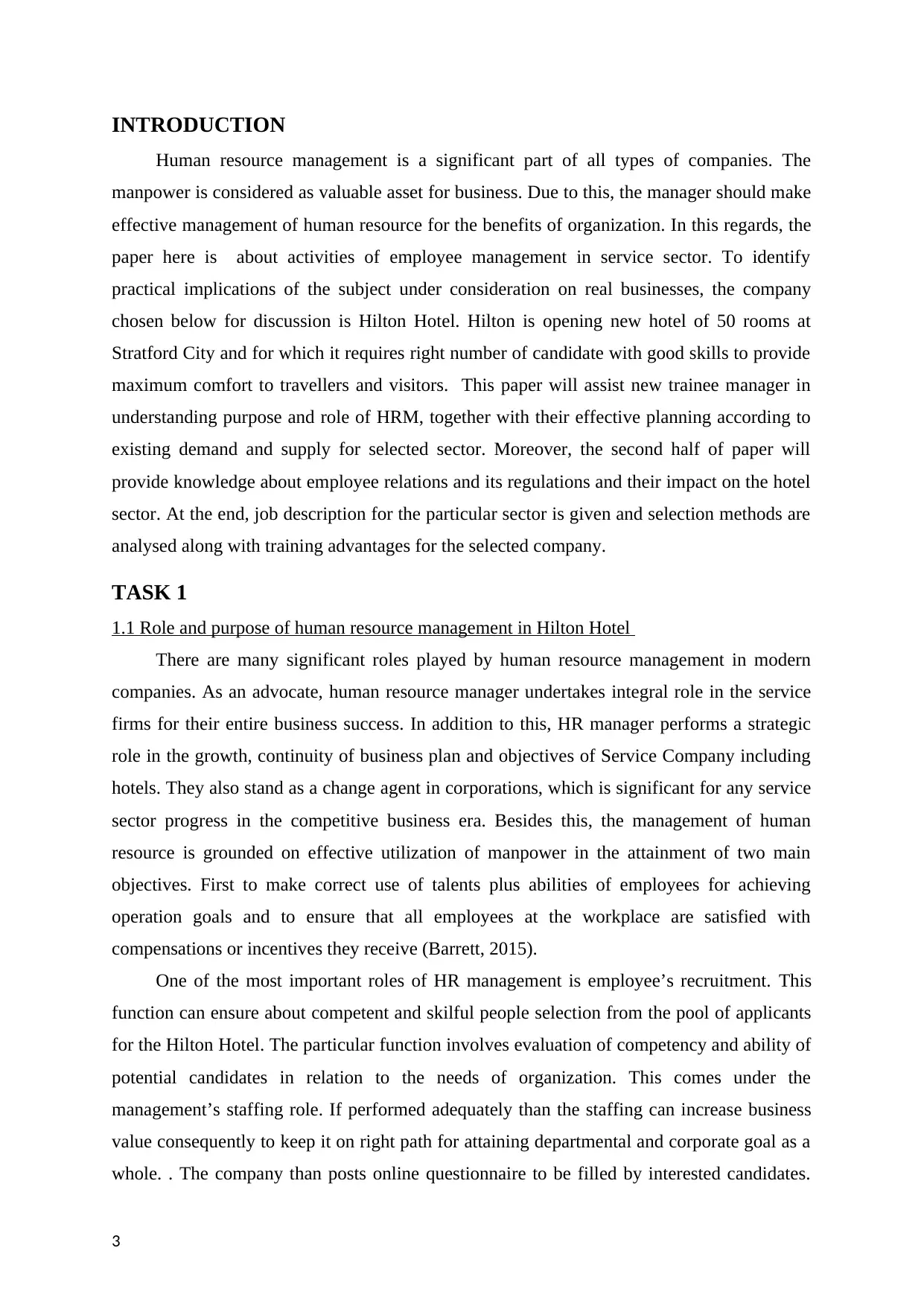
INTRODUCTION
Human resource management is a significant part of all types of companies. The
manpower is considered as valuable asset for business. Due to this, the manager should make
effective management of human resource for the benefits of organization. In this regards, the
paper here is about activities of employee management in service sector. To identify
practical implications of the subject under consideration on real businesses, the company
chosen below for discussion is Hilton Hotel. Hilton is opening new hotel of 50 rooms at
Stratford City and for which it requires right number of candidate with good skills to provide
maximum comfort to travellers and visitors. This paper will assist new trainee manager in
understanding purpose and role of HRM, together with their effective planning according to
existing demand and supply for selected sector. Moreover, the second half of paper will
provide knowledge about employee relations and its regulations and their impact on the hotel
sector. At the end, job description for the particular sector is given and selection methods are
analysed along with training advantages for the selected company.
TASK 1
1.1 Role and purpose of human resource management in Hilton Hotel
There are many significant roles played by human resource management in modern
companies. As an advocate, human resource manager undertakes integral role in the service
firms for their entire business success. In addition to this, HR manager performs a strategic
role in the growth, continuity of business plan and objectives of Service Company including
hotels. They also stand as a change agent in corporations, which is significant for any service
sector progress in the competitive business era. Besides this, the management of human
resource is grounded on effective utilization of manpower in the attainment of two main
objectives. First to make correct use of talents plus abilities of employees for achieving
operation goals and to ensure that all employees at the workplace are satisfied with
compensations or incentives they receive (Barrett, 2015).
One of the most important roles of HR management is employee’s recruitment. This
function can ensure about competent and skilful people selection from the pool of applicants
for the Hilton Hotel. The particular function involves evaluation of competency and ability of
potential candidates in relation to the needs of organization. This comes under the
management’s staffing role. If performed adequately than the staffing can increase business
value consequently to keep it on right path for attaining departmental and corporate goal as a
whole. . The company than posts online questionnaire to be filled by interested candidates.
3
Human resource management is a significant part of all types of companies. The
manpower is considered as valuable asset for business. Due to this, the manager should make
effective management of human resource for the benefits of organization. In this regards, the
paper here is about activities of employee management in service sector. To identify
practical implications of the subject under consideration on real businesses, the company
chosen below for discussion is Hilton Hotel. Hilton is opening new hotel of 50 rooms at
Stratford City and for which it requires right number of candidate with good skills to provide
maximum comfort to travellers and visitors. This paper will assist new trainee manager in
understanding purpose and role of HRM, together with their effective planning according to
existing demand and supply for selected sector. Moreover, the second half of paper will
provide knowledge about employee relations and its regulations and their impact on the hotel
sector. At the end, job description for the particular sector is given and selection methods are
analysed along with training advantages for the selected company.
TASK 1
1.1 Role and purpose of human resource management in Hilton Hotel
There are many significant roles played by human resource management in modern
companies. As an advocate, human resource manager undertakes integral role in the service
firms for their entire business success. In addition to this, HR manager performs a strategic
role in the growth, continuity of business plan and objectives of Service Company including
hotels. They also stand as a change agent in corporations, which is significant for any service
sector progress in the competitive business era. Besides this, the management of human
resource is grounded on effective utilization of manpower in the attainment of two main
objectives. First to make correct use of talents plus abilities of employees for achieving
operation goals and to ensure that all employees at the workplace are satisfied with
compensations or incentives they receive (Barrett, 2015).
One of the most important roles of HR management is employee’s recruitment. This
function can ensure about competent and skilful people selection from the pool of applicants
for the Hilton Hotel. The particular function involves evaluation of competency and ability of
potential candidates in relation to the needs of organization. This comes under the
management’s staffing role. If performed adequately than the staffing can increase business
value consequently to keep it on right path for attaining departmental and corporate goal as a
whole. . The company than posts online questionnaire to be filled by interested candidates.
3
⊘ This is a preview!⊘
Do you want full access?
Subscribe today to unlock all pages.

Trusted by 1+ million students worldwide
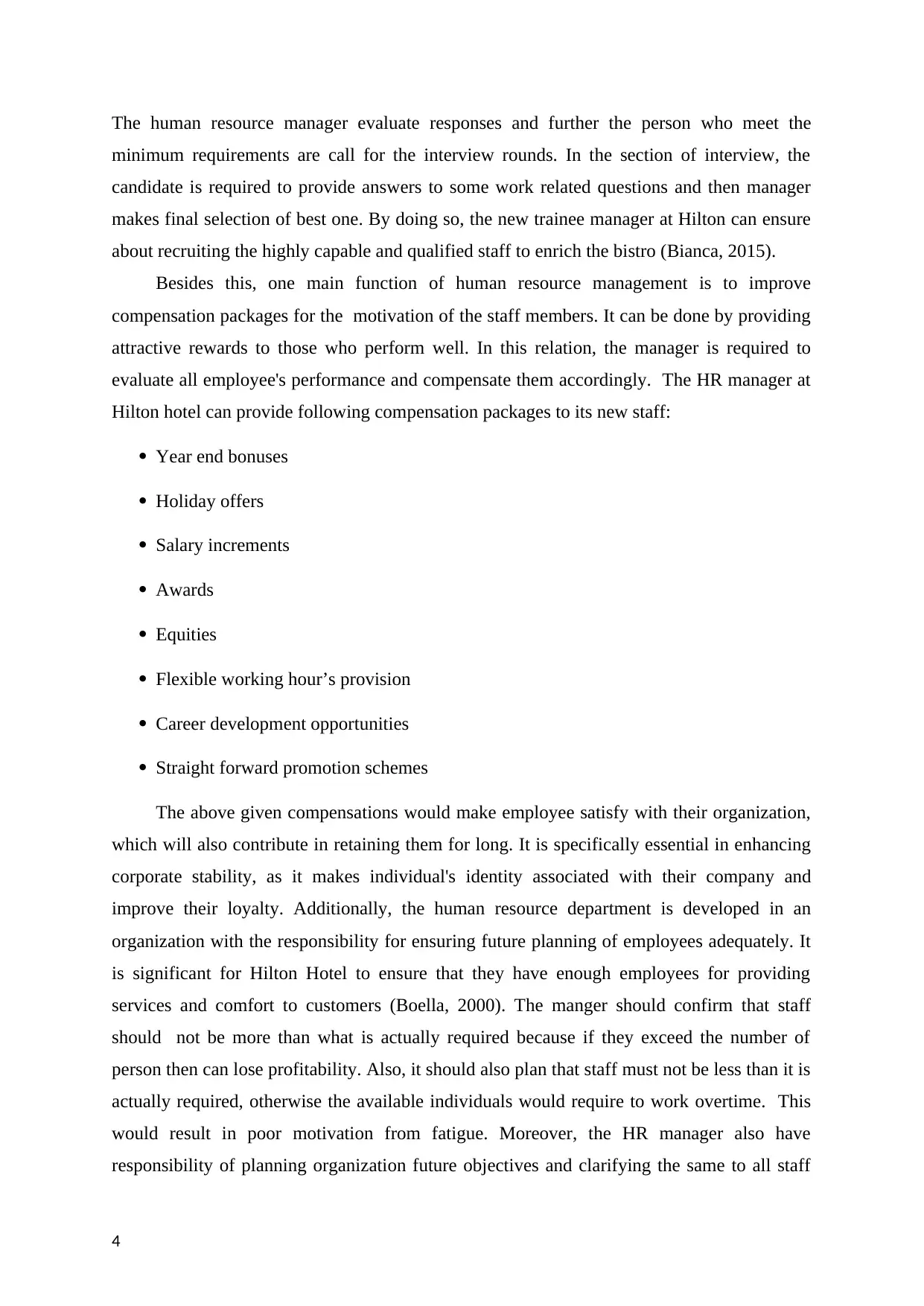
The human resource manager evaluate responses and further the person who meet the
minimum requirements are call for the interview rounds. In the section of interview, the
candidate is required to provide answers to some work related questions and then manager
makes final selection of best one. By doing so, the new trainee manager at Hilton can ensure
about recruiting the highly capable and qualified staff to enrich the bistro (Bianca, 2015).
Besides this, one main function of human resource management is to improve
compensation packages for the motivation of the staff members. It can be done by providing
attractive rewards to those who perform well. In this relation, the manager is required to
evaluate all employee's performance and compensate them accordingly. The HR manager at
Hilton hotel can provide following compensation packages to its new staff:
Year end bonuses
Holiday offers
Salary increments
Awards
Equities
Flexible working hour’s provision
Career development opportunities
Straight forward promotion schemes
The above given compensations would make employee satisfy with their organization,
which will also contribute in retaining them for long. It is specifically essential in enhancing
corporate stability, as it makes individual's identity associated with their company and
improve their loyalty. Additionally, the human resource department is developed in an
organization with the responsibility for ensuring future planning of employees adequately. It
is significant for Hilton Hotel to ensure that they have enough employees for providing
services and comfort to customers (Boella, 2000). The manger should confirm that staff
should not be more than what is actually required because if they exceed the number of
person then can lose profitability. Also, it should also plan that staff must not be less than it is
actually required, otherwise the available individuals would require to work overtime. This
would result in poor motivation from fatigue. Moreover, the HR manager also have
responsibility of planning organization future objectives and clarifying the same to all staff
4
minimum requirements are call for the interview rounds. In the section of interview, the
candidate is required to provide answers to some work related questions and then manager
makes final selection of best one. By doing so, the new trainee manager at Hilton can ensure
about recruiting the highly capable and qualified staff to enrich the bistro (Bianca, 2015).
Besides this, one main function of human resource management is to improve
compensation packages for the motivation of the staff members. It can be done by providing
attractive rewards to those who perform well. In this relation, the manager is required to
evaluate all employee's performance and compensate them accordingly. The HR manager at
Hilton hotel can provide following compensation packages to its new staff:
Year end bonuses
Holiday offers
Salary increments
Awards
Equities
Flexible working hour’s provision
Career development opportunities
Straight forward promotion schemes
The above given compensations would make employee satisfy with their organization,
which will also contribute in retaining them for long. It is specifically essential in enhancing
corporate stability, as it makes individual's identity associated with their company and
improve their loyalty. Additionally, the human resource department is developed in an
organization with the responsibility for ensuring future planning of employees adequately. It
is significant for Hilton Hotel to ensure that they have enough employees for providing
services and comfort to customers (Boella, 2000). The manger should confirm that staff
should not be more than what is actually required because if they exceed the number of
person then can lose profitability. Also, it should also plan that staff must not be less than it is
actually required, otherwise the available individuals would require to work overtime. This
would result in poor motivation from fatigue. Moreover, the HR manager also have
responsibility of planning organization future objectives and clarifying the same to all staff
4
Paraphrase This Document
Need a fresh take? Get an instant paraphrase of this document with our AI Paraphraser
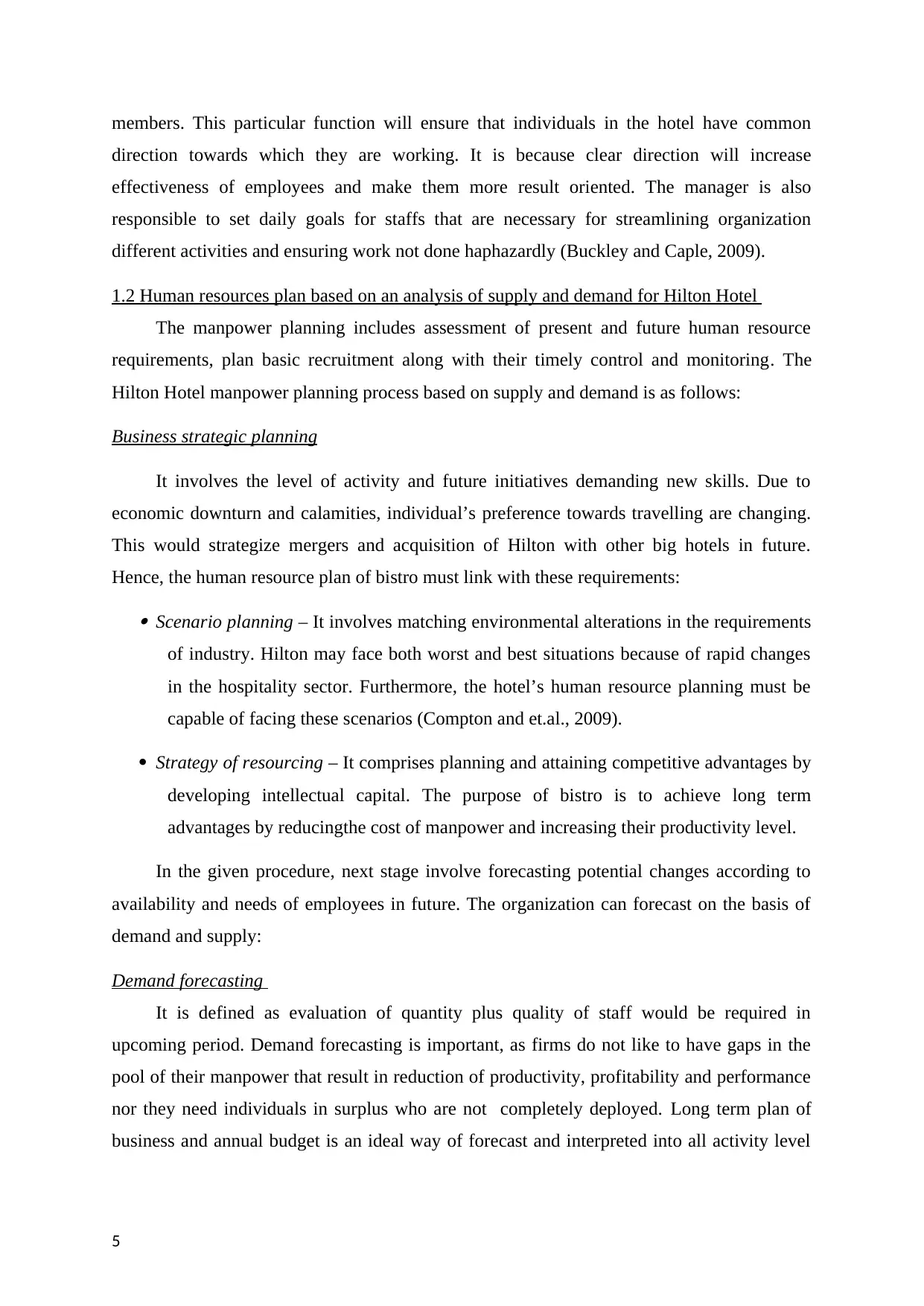
members. This particular function will ensure that individuals in the hotel have common
direction towards which they are working. It is because clear direction will increase
effectiveness of employees and make them more result oriented. The manager is also
responsible to set daily goals for staffs that are necessary for streamlining organization
different activities and ensuring work not done haphazardly (Buckley and Caple, 2009).
1.2 Human resources plan based on an analysis of supply and demand for Hilton Hotel
The manpower planning includes assessment of present and future human resource
requirements, plan basic recruitment along with their timely control and monitoring. The
Hilton Hotel manpower planning process based on supply and demand is as follows:
Business strategic planning
It involves the level of activity and future initiatives demanding new skills. Due to
economic downturn and calamities, individual’s preference towards travelling are changing.
This would strategize mergers and acquisition of Hilton with other big hotels in future.
Hence, the human resource plan of bistro must link with these requirements: Scenario planning – It involves matching environmental alterations in the requirements
of industry. Hilton may face both worst and best situations because of rapid changes
in the hospitality sector. Furthermore, the hotel’s human resource planning must be
capable of facing these scenarios (Compton and et.al., 2009).
Strategy of resourcing – It comprises planning and attaining competitive advantages by
developing intellectual capital. The purpose of bistro is to achieve long term
advantages by reducingthe cost of manpower and increasing their productivity level.
In the given procedure, next stage involve forecasting potential changes according to
availability and needs of employees in future. The organization can forecast on the basis of
demand and supply:
Demand forecasting
It is defined as evaluation of quantity plus quality of staff would be required in
upcoming period. Demand forecasting is important, as firms do not like to have gaps in the
pool of their manpower that result in reduction of productivity, profitability and performance
nor they need individuals in surplus who are not completely deployed. Long term plan of
business and annual budget is an ideal way of forecast and interpreted into all activity level
5
direction towards which they are working. It is because clear direction will increase
effectiveness of employees and make them more result oriented. The manager is also
responsible to set daily goals for staffs that are necessary for streamlining organization
different activities and ensuring work not done haphazardly (Buckley and Caple, 2009).
1.2 Human resources plan based on an analysis of supply and demand for Hilton Hotel
The manpower planning includes assessment of present and future human resource
requirements, plan basic recruitment along with their timely control and monitoring. The
Hilton Hotel manpower planning process based on supply and demand is as follows:
Business strategic planning
It involves the level of activity and future initiatives demanding new skills. Due to
economic downturn and calamities, individual’s preference towards travelling are changing.
This would strategize mergers and acquisition of Hilton with other big hotels in future.
Hence, the human resource plan of bistro must link with these requirements: Scenario planning – It involves matching environmental alterations in the requirements
of industry. Hilton may face both worst and best situations because of rapid changes
in the hospitality sector. Furthermore, the hotel’s human resource planning must be
capable of facing these scenarios (Compton and et.al., 2009).
Strategy of resourcing – It comprises planning and attaining competitive advantages by
developing intellectual capital. The purpose of bistro is to achieve long term
advantages by reducingthe cost of manpower and increasing their productivity level.
In the given procedure, next stage involve forecasting potential changes according to
availability and needs of employees in future. The organization can forecast on the basis of
demand and supply:
Demand forecasting
It is defined as evaluation of quantity plus quality of staff would be required in
upcoming period. Demand forecasting is important, as firms do not like to have gaps in the
pool of their manpower that result in reduction of productivity, profitability and performance
nor they need individuals in surplus who are not completely deployed. Long term plan of
business and annual budget is an ideal way of forecast and interpreted into all activity level
5
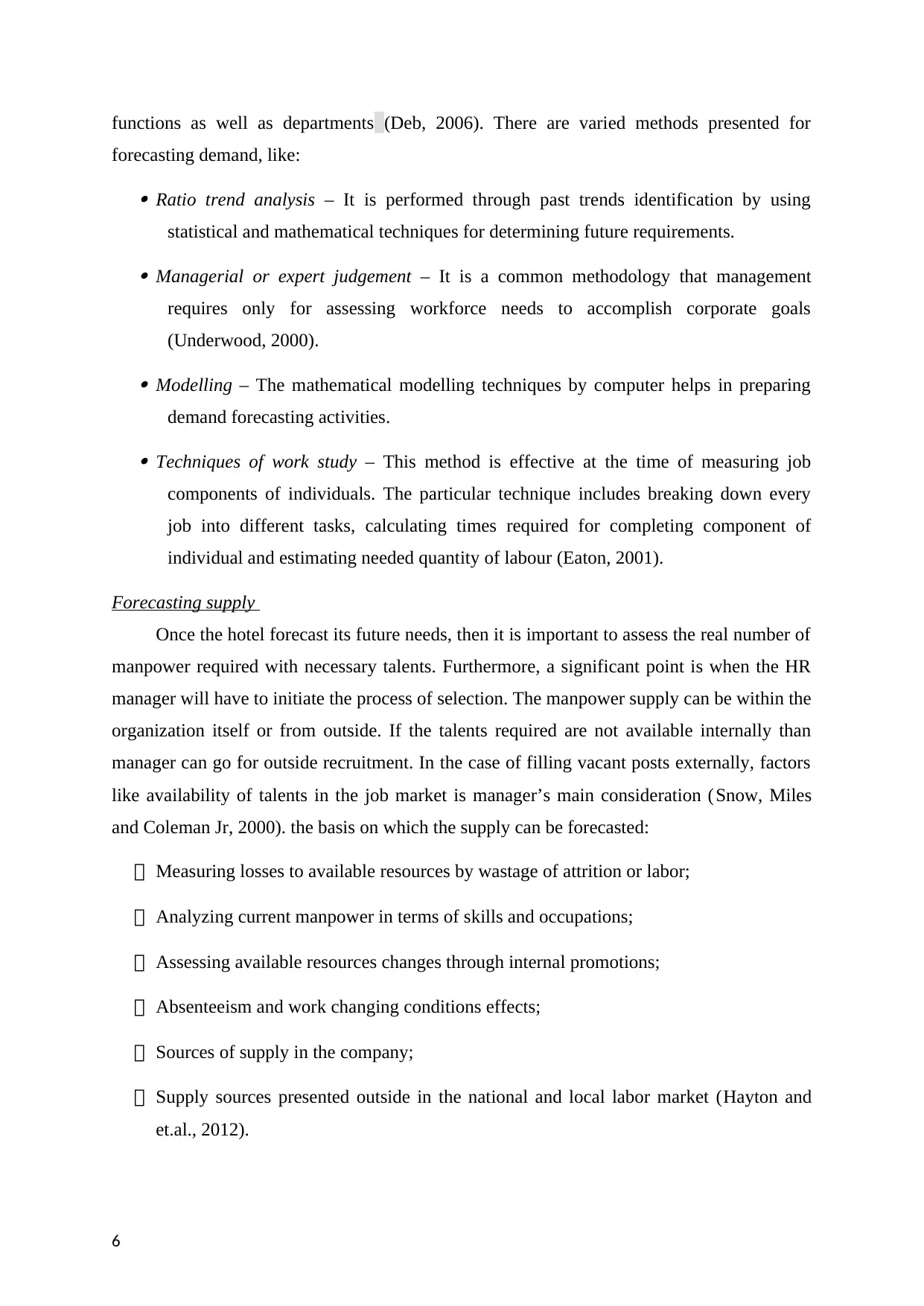
functions as well as departments (Deb, 2006). There are varied methods presented for
forecasting demand, like: Ratio trend analysis – It is performed through past trends identification by using
statistical and mathematical techniques for determining future requirements. Managerial or expert judgement – It is a common methodology that management
requires only for assessing workforce needs to accomplish corporate goals
(Underwood, 2000). Modelling – The mathematical modelling techniques by computer helps in preparing
demand forecasting activities. Techniques of work study – This method is effective at the time of measuring job
components of individuals. The particular technique includes breaking down every
job into different tasks, calculating times required for completing component of
individual and estimating needed quantity of labour (Eaton, 2001).
Forecasting supply
Once the hotel forecast its future needs, then it is important to assess the real number of
manpower required with necessary talents. Furthermore, a significant point is when the HR
manager will have to initiate the process of selection. The manpower supply can be within the
organization itself or from outside. If the talents required are not available internally than
manager can go for outside recruitment. In the case of filling vacant posts externally, factors
like availability of talents in the job market is manager’s main consideration (Snow, Miles
and Coleman Jr, 2000). the basis on which the supply can be forecasted:
Measuring losses to available resources by wastage of attrition or labor;
Analyzing current manpower in terms of skills and occupations;
Assessing available resources changes through internal promotions;
Absenteeism and work changing conditions effects;
Sources of supply in the company;
Supply sources presented outside in the national and local labor market (Hayton and
et.al., 2012).
6
forecasting demand, like: Ratio trend analysis – It is performed through past trends identification by using
statistical and mathematical techniques for determining future requirements. Managerial or expert judgement – It is a common methodology that management
requires only for assessing workforce needs to accomplish corporate goals
(Underwood, 2000). Modelling – The mathematical modelling techniques by computer helps in preparing
demand forecasting activities. Techniques of work study – This method is effective at the time of measuring job
components of individuals. The particular technique includes breaking down every
job into different tasks, calculating times required for completing component of
individual and estimating needed quantity of labour (Eaton, 2001).
Forecasting supply
Once the hotel forecast its future needs, then it is important to assess the real number of
manpower required with necessary talents. Furthermore, a significant point is when the HR
manager will have to initiate the process of selection. The manpower supply can be within the
organization itself or from outside. If the talents required are not available internally than
manager can go for outside recruitment. In the case of filling vacant posts externally, factors
like availability of talents in the job market is manager’s main consideration (Snow, Miles
and Coleman Jr, 2000). the basis on which the supply can be forecasted:
Measuring losses to available resources by wastage of attrition or labor;
Analyzing current manpower in terms of skills and occupations;
Assessing available resources changes through internal promotions;
Absenteeism and work changing conditions effects;
Sources of supply in the company;
Supply sources presented outside in the national and local labor market (Hayton and
et.al., 2012).
6
⊘ This is a preview!⊘
Do you want full access?
Subscribe today to unlock all pages.

Trusted by 1+ million students worldwide
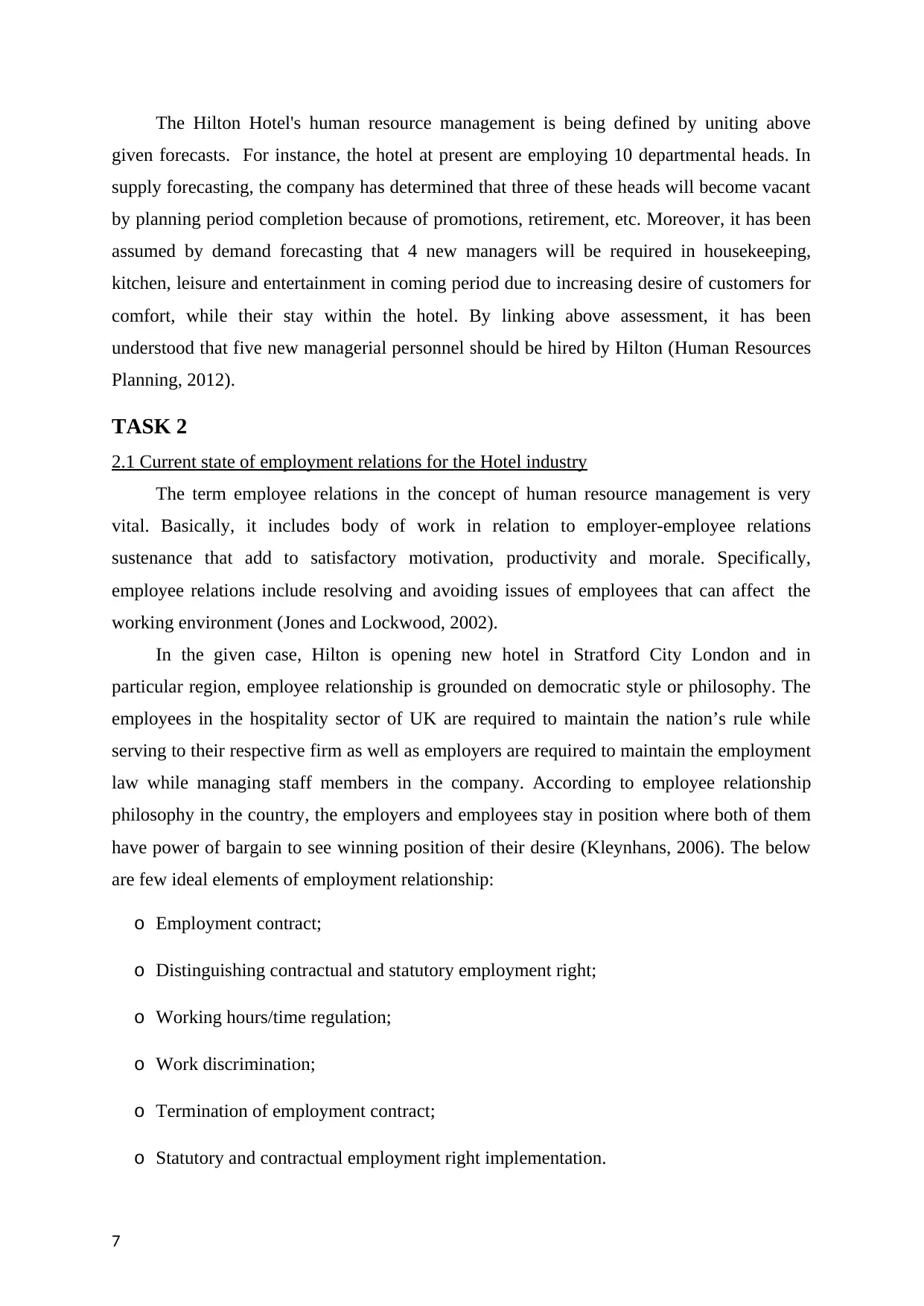
The Hilton Hotel's human resource management is being defined by uniting above
given forecasts. For instance, the hotel at present are employing 10 departmental heads. In
supply forecasting, the company has determined that three of these heads will become vacant
by planning period completion because of promotions, retirement, etc. Moreover, it has been
assumed by demand forecasting that 4 new managers will be required in housekeeping,
kitchen, leisure and entertainment in coming period due to increasing desire of customers for
comfort, while their stay within the hotel. By linking above assessment, it has been
understood that five new managerial personnel should be hired by Hilton (Human Resources
Planning, 2012).
TASK 2
2.1 Current state of employment relations for the Hotel industry
The term employee relations in the concept of human resource management is very
vital. Basically, it includes body of work in relation to employer-employee relations
sustenance that add to satisfactory motivation, productivity and morale. Specifically,
employee relations include resolving and avoiding issues of employees that can affect the
working environment (Jones and Lockwood, 2002).
In the given case, Hilton is opening new hotel in Stratford City London and in
particular region, employee relationship is grounded on democratic style or philosophy. The
employees in the hospitality sector of UK are required to maintain the nation’s rule while
serving to their respective firm as well as employers are required to maintain the employment
law while managing staff members in the company. According to employee relationship
philosophy in the country, the employers and employees stay in position where both of them
have power of bargain to see winning position of their desire (Kleynhans, 2006). The below
are few ideal elements of employment relationship:
o Employment contract;
o Distinguishing contractual and statutory employment right;
o Working hours/time regulation;
o Work discrimination;
o Termination of employment contract;
o Statutory and contractual employment right implementation.
7
given forecasts. For instance, the hotel at present are employing 10 departmental heads. In
supply forecasting, the company has determined that three of these heads will become vacant
by planning period completion because of promotions, retirement, etc. Moreover, it has been
assumed by demand forecasting that 4 new managers will be required in housekeeping,
kitchen, leisure and entertainment in coming period due to increasing desire of customers for
comfort, while their stay within the hotel. By linking above assessment, it has been
understood that five new managerial personnel should be hired by Hilton (Human Resources
Planning, 2012).
TASK 2
2.1 Current state of employment relations for the Hotel industry
The term employee relations in the concept of human resource management is very
vital. Basically, it includes body of work in relation to employer-employee relations
sustenance that add to satisfactory motivation, productivity and morale. Specifically,
employee relations include resolving and avoiding issues of employees that can affect the
working environment (Jones and Lockwood, 2002).
In the given case, Hilton is opening new hotel in Stratford City London and in
particular region, employee relationship is grounded on democratic style or philosophy. The
employees in the hospitality sector of UK are required to maintain the nation’s rule while
serving to their respective firm as well as employers are required to maintain the employment
law while managing staff members in the company. According to employee relationship
philosophy in the country, the employers and employees stay in position where both of them
have power of bargain to see winning position of their desire (Kleynhans, 2006). The below
are few ideal elements of employment relationship:
o Employment contract;
o Distinguishing contractual and statutory employment right;
o Working hours/time regulation;
o Work discrimination;
o Termination of employment contract;
o Statutory and contractual employment right implementation.
7
Paraphrase This Document
Need a fresh take? Get an instant paraphrase of this document with our AI Paraphraser
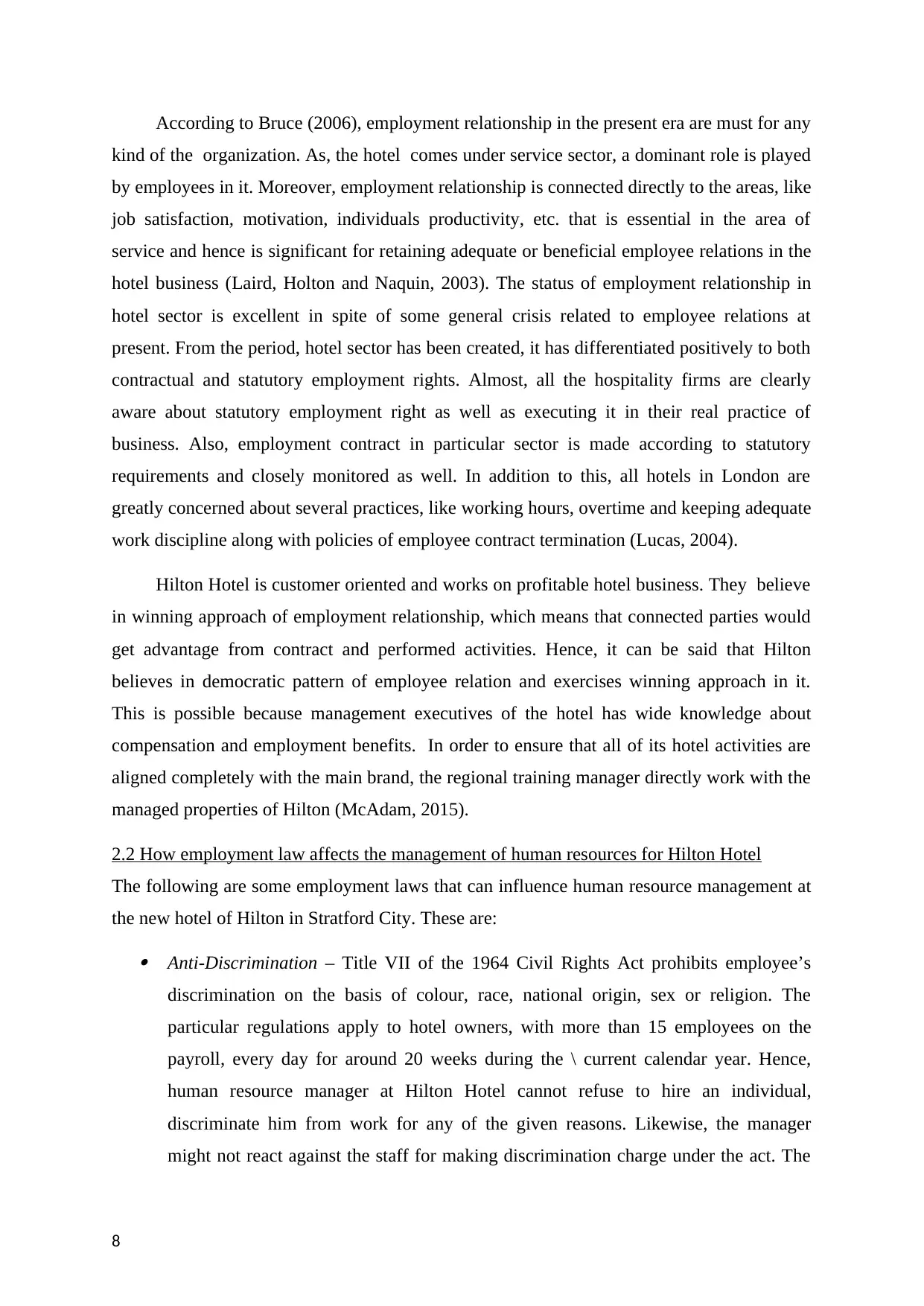
According to Bruce (2006), employment relationship in the present era are must for any
kind of the organization. As, the hotel comes under service sector, a dominant role is played
by employees in it. Moreover, employment relationship is connected directly to the areas, like
job satisfaction, motivation, individuals productivity, etc. that is essential in the area of
service and hence is significant for retaining adequate or beneficial employee relations in the
hotel business (Laird, Holton and Naquin, 2003). The status of employment relationship in
hotel sector is excellent in spite of some general crisis related to employee relations at
present. From the period, hotel sector has been created, it has differentiated positively to both
contractual and statutory employment rights. Almost, all the hospitality firms are clearly
aware about statutory employment right as well as executing it in their real practice of
business. Also, employment contract in particular sector is made according to statutory
requirements and closely monitored as well. In addition to this, all hotels in London are
greatly concerned about several practices, like working hours, overtime and keeping adequate
work discipline along with policies of employee contract termination (Lucas, 2004).
Hilton Hotel is customer oriented and works on profitable hotel business. They believe
in winning approach of employment relationship, which means that connected parties would
get advantage from contract and performed activities. Hence, it can be said that Hilton
believes in democratic pattern of employee relation and exercises winning approach in it.
This is possible because management executives of the hotel has wide knowledge about
compensation and employment benefits. In order to ensure that all of its hotel activities are
aligned completely with the main brand, the regional training manager directly work with the
managed properties of Hilton (McAdam, 2015).
2.2 How employment law affects the management of human resources for Hilton Hotel
The following are some employment laws that can influence human resource management at
the new hotel of Hilton in Stratford City. These are: Anti-Discrimination – Title VII of the 1964 Civil Rights Act prohibits employee’s
discrimination on the basis of colour, race, national origin, sex or religion. The
particular regulations apply to hotel owners, with more than 15 employees on the
payroll, every day for around 20 weeks during the \ current calendar year. Hence,
human resource manager at Hilton Hotel cannot refuse to hire an individual,
discriminate him from work for any of the given reasons. Likewise, the manager
might not react against the staff for making discrimination charge under the act. The
8
kind of the organization. As, the hotel comes under service sector, a dominant role is played
by employees in it. Moreover, employment relationship is connected directly to the areas, like
job satisfaction, motivation, individuals productivity, etc. that is essential in the area of
service and hence is significant for retaining adequate or beneficial employee relations in the
hotel business (Laird, Holton and Naquin, 2003). The status of employment relationship in
hotel sector is excellent in spite of some general crisis related to employee relations at
present. From the period, hotel sector has been created, it has differentiated positively to both
contractual and statutory employment rights. Almost, all the hospitality firms are clearly
aware about statutory employment right as well as executing it in their real practice of
business. Also, employment contract in particular sector is made according to statutory
requirements and closely monitored as well. In addition to this, all hotels in London are
greatly concerned about several practices, like working hours, overtime and keeping adequate
work discipline along with policies of employee contract termination (Lucas, 2004).
Hilton Hotel is customer oriented and works on profitable hotel business. They believe
in winning approach of employment relationship, which means that connected parties would
get advantage from contract and performed activities. Hence, it can be said that Hilton
believes in democratic pattern of employee relation and exercises winning approach in it.
This is possible because management executives of the hotel has wide knowledge about
compensation and employment benefits. In order to ensure that all of its hotel activities are
aligned completely with the main brand, the regional training manager directly work with the
managed properties of Hilton (McAdam, 2015).
2.2 How employment law affects the management of human resources for Hilton Hotel
The following are some employment laws that can influence human resource management at
the new hotel of Hilton in Stratford City. These are: Anti-Discrimination – Title VII of the 1964 Civil Rights Act prohibits employee’s
discrimination on the basis of colour, race, national origin, sex or religion. The
particular regulations apply to hotel owners, with more than 15 employees on the
payroll, every day for around 20 weeks during the \ current calendar year. Hence,
human resource manager at Hilton Hotel cannot refuse to hire an individual,
discriminate him from work for any of the given reasons. Likewise, the manager
might not react against the staff for making discrimination charge under the act. The
8
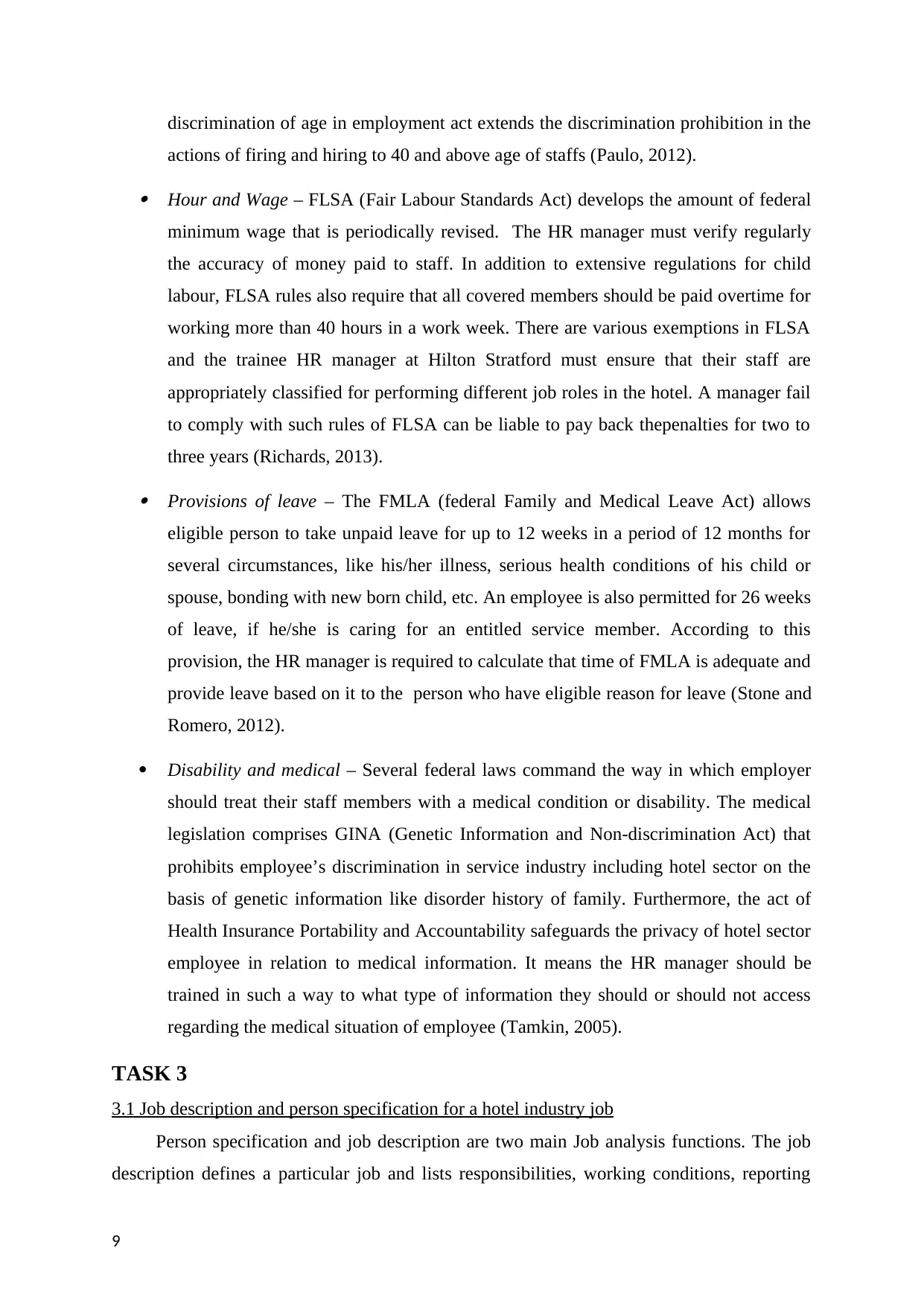
discrimination of age in employment act extends the discrimination prohibition in the
actions of firing and hiring to 40 and above age of staffs (Paulo, 2012). Hour and Wage – FLSA (Fair Labour Standards Act) develops the amount of federal
minimum wage that is periodically revised. The HR manager must verify regularly
the accuracy of money paid to staff. In addition to extensive regulations for child
labour, FLSA rules also require that all covered members should be paid overtime for
working more than 40 hours in a work week. There are various exemptions in FLSA
and the trainee HR manager at Hilton Stratford must ensure that their staff are
appropriately classified for performing different job roles in the hotel. A manager fail
to comply with such rules of FLSA can be liable to pay back thepenalties for two to
three years (Richards, 2013). Provisions of leave – The FMLA (federal Family and Medical Leave Act) allows
eligible person to take unpaid leave for up to 12 weeks in a period of 12 months for
several circumstances, like his/her illness, serious health conditions of his child or
spouse, bonding with new born child, etc. An employee is also permitted for 26 weeks
of leave, if he/she is caring for an entitled service member. According to this
provision, the HR manager is required to calculate that time of FMLA is adequate and
provide leave based on it to the person who have eligible reason for leave (Stone and
Romero, 2012).
Disability and medical – Several federal laws command the way in which employer
should treat their staff members with a medical condition or disability. The medical
legislation comprises GINA (Genetic Information and Non-discrimination Act) that
prohibits employee’s discrimination in service industry including hotel sector on the
basis of genetic information like disorder history of family. Furthermore, the act of
Health Insurance Portability and Accountability safeguards the privacy of hotel sector
employee in relation to medical information. It means the HR manager should be
trained in such a way to what type of information they should or should not access
regarding the medical situation of employee (Tamkin, 2005).
TASK 3
3.1 Job description and person specification for a hotel industry job
Person specification and job description are two main Job analysis functions. The job
description defines a particular job and lists responsibilities, working conditions, reporting
9
actions of firing and hiring to 40 and above age of staffs (Paulo, 2012). Hour and Wage – FLSA (Fair Labour Standards Act) develops the amount of federal
minimum wage that is periodically revised. The HR manager must verify regularly
the accuracy of money paid to staff. In addition to extensive regulations for child
labour, FLSA rules also require that all covered members should be paid overtime for
working more than 40 hours in a work week. There are various exemptions in FLSA
and the trainee HR manager at Hilton Stratford must ensure that their staff are
appropriately classified for performing different job roles in the hotel. A manager fail
to comply with such rules of FLSA can be liable to pay back thepenalties for two to
three years (Richards, 2013). Provisions of leave – The FMLA (federal Family and Medical Leave Act) allows
eligible person to take unpaid leave for up to 12 weeks in a period of 12 months for
several circumstances, like his/her illness, serious health conditions of his child or
spouse, bonding with new born child, etc. An employee is also permitted for 26 weeks
of leave, if he/she is caring for an entitled service member. According to this
provision, the HR manager is required to calculate that time of FMLA is adequate and
provide leave based on it to the person who have eligible reason for leave (Stone and
Romero, 2012).
Disability and medical – Several federal laws command the way in which employer
should treat their staff members with a medical condition or disability. The medical
legislation comprises GINA (Genetic Information and Non-discrimination Act) that
prohibits employee’s discrimination in service industry including hotel sector on the
basis of genetic information like disorder history of family. Furthermore, the act of
Health Insurance Portability and Accountability safeguards the privacy of hotel sector
employee in relation to medical information. It means the HR manager should be
trained in such a way to what type of information they should or should not access
regarding the medical situation of employee (Tamkin, 2005).
TASK 3
3.1 Job description and person specification for a hotel industry job
Person specification and job description are two main Job analysis functions. The job
description defines a particular job and lists responsibilities, working conditions, reporting
9
⊘ This is a preview!⊘
Do you want full access?
Subscribe today to unlock all pages.

Trusted by 1+ million students worldwide

relations and supervisory responsibilities, etc. While the person specification is referred to the
statement of employee qualifications and characteristics needed for the satisfactory
performance of defined tasks and duties included in a particular job (Aguinis and Kraiger,
2009).
The following is job description and person specification of various hotel sector jobs:
1. Title – Receptionist
Department – Front office
Report to – Administration manager
Purpose of job
To ensure demonstration of welcome with hospitality standard.
Main responsibilities
Reservation duties – The person should be aware of promotions offer and pass the
information to visitors. Moreover, he/she should promote other units in the hotel to
increase sales. The receptionist also require to ensure about correct deposit of
reservation and sending confirmations about shifts (Albrecht, 2007).
Reception duties – Provide standard services and offer assistance to other departments
of hotel. It is the duty of receptionist to anticipate needs of guests fulfill in courteous
manner. Moreover, undertake reception duties by following process given in S.O.P
manual (Antony and et.al., 2007).
Person Specification
Qualification – GCSE standard English or Math.
Experience
- Experience to work with busy environment of hotel
- Working experience with confidential information
Skills
- Written and oral communication skills
- Numeric skills
- Can use computer programs
10
statement of employee qualifications and characteristics needed for the satisfactory
performance of defined tasks and duties included in a particular job (Aguinis and Kraiger,
2009).
The following is job description and person specification of various hotel sector jobs:
1. Title – Receptionist
Department – Front office
Report to – Administration manager
Purpose of job
To ensure demonstration of welcome with hospitality standard.
Main responsibilities
Reservation duties – The person should be aware of promotions offer and pass the
information to visitors. Moreover, he/she should promote other units in the hotel to
increase sales. The receptionist also require to ensure about correct deposit of
reservation and sending confirmations about shifts (Albrecht, 2007).
Reception duties – Provide standard services and offer assistance to other departments
of hotel. It is the duty of receptionist to anticipate needs of guests fulfill in courteous
manner. Moreover, undertake reception duties by following process given in S.O.P
manual (Antony and et.al., 2007).
Person Specification
Qualification – GCSE standard English or Math.
Experience
- Experience to work with busy environment of hotel
- Working experience with confidential information
Skills
- Written and oral communication skills
- Numeric skills
- Can use computer programs
10
Paraphrase This Document
Need a fresh take? Get an instant paraphrase of this document with our AI Paraphraser

- Understanding of customer service
Personal Attributes
- Ability to work under pressure
- Communicate with varied range of individuals
- Develop and maintain good working relations with customers and colleagues
- Self-motivated to complete non-routine and routine tasks
2. Title - Banquet manager
Department – F&B
Position summary
Supervises and directs the activities of barman and waiter.
Responsibilities
Guiding the waiters in their job performance;
Ensuring sufficient supplies of operating equipment and beverages;
Responsible for overall cleanliness and sanitation of banquet rooms, storage areas and
work areas;
Responsible for adequate utilization and proper working order of all furniture,
equipment plus fixtures in Catering and Banquet section;
Ensure about consistent implementation of operating process and service standards in
catering and banquet service (Bessant and Tsekouras, 2001).
Person Specification
Qualification – Graduate from college
Experience – Working in F&B department of boutique hotel
Communication – Good verbal and written English
Working hours – Can work in flexible hours according to requirements of job
3. Title – Waiter
Position summary
11
Personal Attributes
- Ability to work under pressure
- Communicate with varied range of individuals
- Develop and maintain good working relations with customers and colleagues
- Self-motivated to complete non-routine and routine tasks
2. Title - Banquet manager
Department – F&B
Position summary
Supervises and directs the activities of barman and waiter.
Responsibilities
Guiding the waiters in their job performance;
Ensuring sufficient supplies of operating equipment and beverages;
Responsible for overall cleanliness and sanitation of banquet rooms, storage areas and
work areas;
Responsible for adequate utilization and proper working order of all furniture,
equipment plus fixtures in Catering and Banquet section;
Ensure about consistent implementation of operating process and service standards in
catering and banquet service (Bessant and Tsekouras, 2001).
Person Specification
Qualification – Graduate from college
Experience – Working in F&B department of boutique hotel
Communication – Good verbal and written English
Working hours – Can work in flexible hours according to requirements of job
3. Title – Waiter
Position summary
11
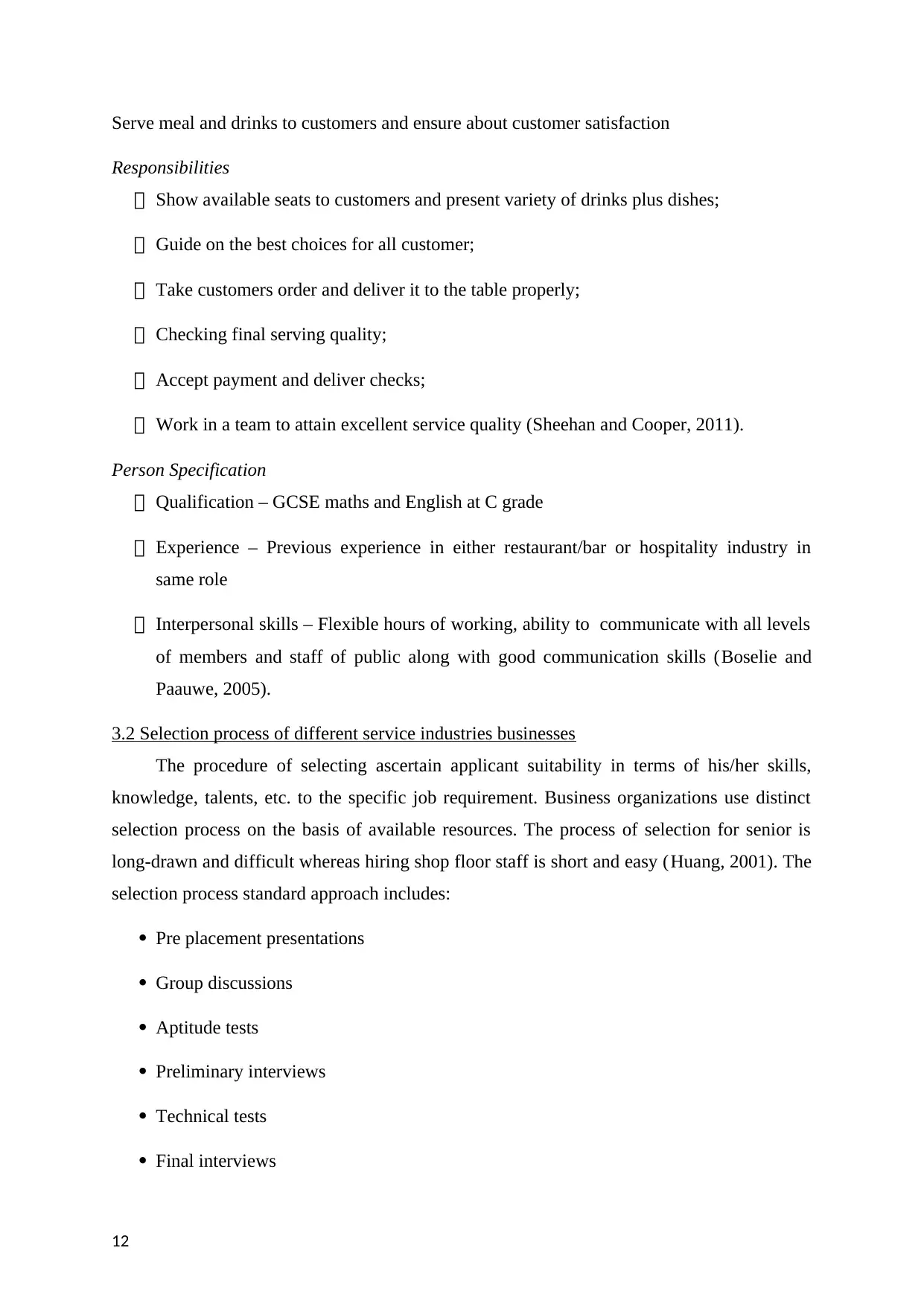
Serve meal and drinks to customers and ensure about customer satisfaction
Responsibilities
Show available seats to customers and present variety of drinks plus dishes;
Guide on the best choices for all customer;
Take customers order and deliver it to the table properly;
Checking final serving quality;
Accept payment and deliver checks;
Work in a team to attain excellent service quality (Sheehan and Cooper, 2011).
Person Specification
Qualification – GCSE maths and English at C grade
Experience – Previous experience in either restaurant/bar or hospitality industry in
same role
Interpersonal skills – Flexible hours of working, ability to communicate with all levels
of members and staff of public along with good communication skills (Boselie and
Paauwe, 2005).
3.2 Selection process of different service industries businesses
The procedure of selecting ascertain applicant suitability in terms of his/her skills,
knowledge, talents, etc. to the specific job requirement. Business organizations use distinct
selection process on the basis of available resources. The process of selection for senior is
long-drawn and difficult whereas hiring shop floor staff is short and easy (Huang, 2001). The
selection process standard approach includes:
Pre placement presentations
Group discussions
Aptitude tests
Preliminary interviews
Technical tests
Final interviews
12
Responsibilities
Show available seats to customers and present variety of drinks plus dishes;
Guide on the best choices for all customer;
Take customers order and deliver it to the table properly;
Checking final serving quality;
Accept payment and deliver checks;
Work in a team to attain excellent service quality (Sheehan and Cooper, 2011).
Person Specification
Qualification – GCSE maths and English at C grade
Experience – Previous experience in either restaurant/bar or hospitality industry in
same role
Interpersonal skills – Flexible hours of working, ability to communicate with all levels
of members and staff of public along with good communication skills (Boselie and
Paauwe, 2005).
3.2 Selection process of different service industries businesses
The procedure of selecting ascertain applicant suitability in terms of his/her skills,
knowledge, talents, etc. to the specific job requirement. Business organizations use distinct
selection process on the basis of available resources. The process of selection for senior is
long-drawn and difficult whereas hiring shop floor staff is short and easy (Huang, 2001). The
selection process standard approach includes:
Pre placement presentations
Group discussions
Aptitude tests
Preliminary interviews
Technical tests
Final interviews
12
⊘ This is a preview!⊘
Do you want full access?
Subscribe today to unlock all pages.

Trusted by 1+ million students worldwide
1 out of 18
Related Documents
Your All-in-One AI-Powered Toolkit for Academic Success.
+13062052269
info@desklib.com
Available 24*7 on WhatsApp / Email
![[object Object]](/_next/static/media/star-bottom.7253800d.svg)
Unlock your academic potential
Copyright © 2020–2025 A2Z Services. All Rights Reserved. Developed and managed by ZUCOL.





